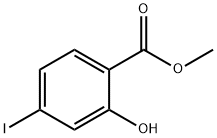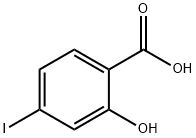General procedure for the synthesis of methyl 4-iodosalicylate from 2-hydroxy-4-iodobenzoic acid and iodomethane: 4-iodosalicylic acid (7.3 g, 27.65 mmol) was dissolved in 41 mL of DMF, NaHCO3 (2.78 g, 33.18 mmol) was added, and CO2 was released during the reaction and the mixture was stirred for 5 min. Iodomethane (2.66 mL, 5.85 g, 41.47 mmol, 1.5 eq.) was then added and the reaction mixture was heated with stirring at 40 °C for 5 h (the reaction progress was monitored by TLC). After completion of the reaction, the mixture was diluted with 170 mL of water and 170 mL of ethyl acetate (EA). The organic layer was washed sequentially with 170 mL of 5% NaHCO3 solution and 170 mL of 5% NaCl solution and dried with Na2SO4. Evaporation of the solvent gave about 9 g of crude product (in the form of a black oil), which was purified by column chromatography: 100 g of silica gel (SiO2) was used as stationary phase, and the eluent was pure hexane, which was subsequently adjusted to a solvent mixture of hexane:ethyl acetate (100:2). Finally, 5.86 g of pure product was obtained in 76.5% yield.




